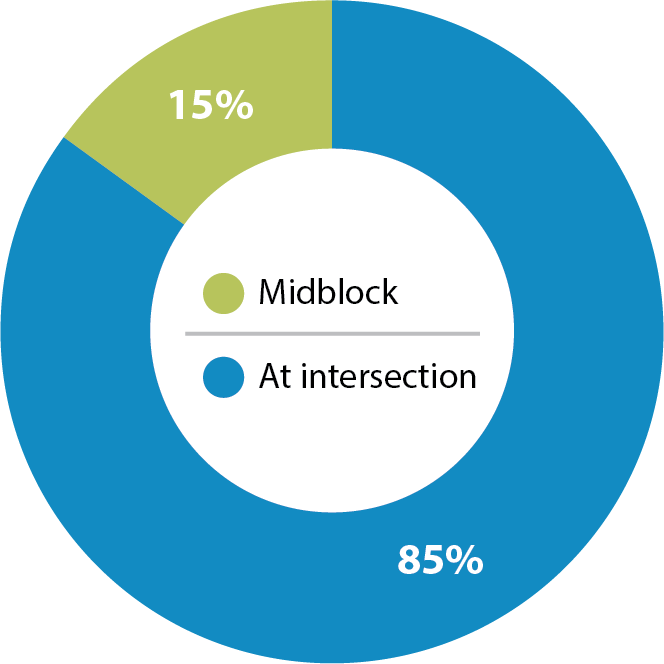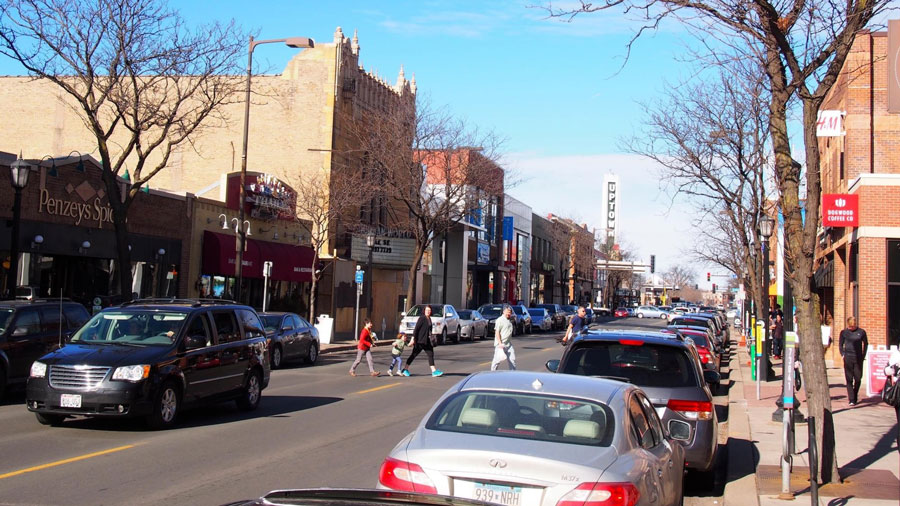Strategy 2 Prioritize visibility and safety of pedestrians at intersections and midblock crossings.
The actions within this strategy are divided into two categories:
Action we will DOActions we will SUPPORTAction we will do are followed by “DO” and are colored in dark gray, and actions we will support are followed by “SUPPORT” and are colored in light gray.
Learn more about how we get there85% of crashes involving pedestrians happen at intersections. Of these, 68% of crashes happen at signalized intersections, while 30% happen at unsignalized or stop-controlled intersections.1 While midblock crossings are not the norm in Minneapolis, where they exist, it is important to prioritize treatments that slow motor vehicle speed and provide visual cues for drivers to look for people crossing, particularly because drivers may not be anticipating people crossing midblock.
There are several operational improvements that help increase safety but may sometimes appear at odds with one another. Longer walk signals, for example, support walking speeds for those who have a slower pace, but shorter walk signals allow opportunities for people to cross more frequently. Assessing when and where these various treatments is important and most effective on a project by project basis.
- Minneapolis Pedestrian Crash Study, 2017. 2% are at no or unknown control.
Actions to prioritize visibility and safety of pedestrians at intersections and midblock crossings.
Walking 2.1
Modify traffic signal operation to give pedestrians a walk signal at signalized intersections without having to press a button except where doing so would provide greater benefit to pedestrians, bicyclists, transit and neighborhoods. Explore permanent sign modifications to indicate whether the button needs to be pressed to get a walk phase or longer walk phase. Note that the ADA requires pedestrian pushbuttons be installed to provide audio and vibrotactile information to pedestrians when activated.
Supported goals:
Safety Equity Mobility
Related actions:
Difficulty:
Low
Timeframe:
2020-2023 (Years 0-3)
Walking 2.2
Develop criteria for adding marked and/or raised crosswalks at unsignalized intersections and designated midblock crossings to reduce distances between formalized crossings. Widen existing crosswalk markings to accommodate pedestrian volumes.
Supported goals:
Safety Mobility
Related actions:
Difficulty:
Medium
Timeframe:
2020-2023 (Years 0-3)
Walking 2.3
Adjust and restrict vehicle turns at intersections through street design and operational strategies based on street context and data. This includes strategies such as ‘No Turn on Red’, stop bars set back further from the pedestrian crossing, leading pedestrian intervals, pedestrian scrambles, left turn restrictions, lagging left turns, hardened centerlines, slow turn wedges and smaller turning radii to slow vehicle turns.
Supported goals:
Safety
Related actions:
Difficulty:
Medium
Timeframe:
2024-2027 (Years 4-7)
Walking 2.4
Restrict the installation of new slip lanes (unsignalized turn lanes at intersections) and convert existing slip lanes to community space.
Supported goals:
Safety
Related actions:
Design 2.1, Design 2.2, Design 2.3, Design 2.4, Design 2.5, Design 2.6
Difficulty:
Medium
Timeframe:
2020-2023 (Years 0-3)
Status:
On-going
Walking 2.5
Prioritize the implementation of curb extensions, pedestrian crossing medians, tabled crossings, interim painted curb extensions, and related safety improvements along and across the Pedestrian Priority Network and High Injury Streets.
Supported goals:
Safety
Related actions:
Difficulty:
Low
Timeframe:
2020-2023 (Years 0-3)
Status:
On-going
Walking 2.6
Implement pedestrian and bicycle improvements near or connecting to schools through the City’s Safe Routes to School program and other opportunities to encourage students to walk or bicycle to/from school.
Supported goals:
Safety Mobility Active Partnerships
Related actions:
Bicycles 2.1, Bicycles 2.2, Bicycles 2.3, Bicycles 2.4, Bicycles 2.5, Bicycles 2.6
Difficulty:
High
Timeframe:
2024-2027 (Years 4-7)
Walking 2.7
Discontinue the use of vehicular level of service and/or vehicle counts as sole justification for the installation of traffic signals, and include pedestrian and bicycle counts in the evaluation of new traffic signal need.
Supported goals:
Safety Mobility
Related actions:
Operations 3.2
Difficulty:
Medium
Timeframe:
2020-2023 (Years 0-3)
Status:
On-going


